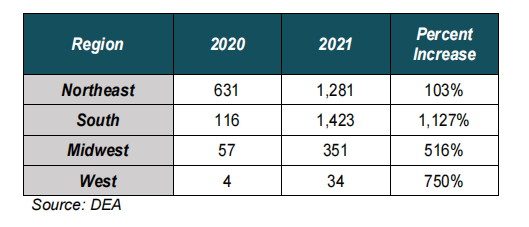News
Xylazine (also known as “tranq”) is a non-opiate sedative, analgesic, and muscle relaxant only authorized in the United States for veterinary use according to the U.S. Food and Drug Administration, and is not approved for human use.
Xylazine as an adulterant in illicit drug mixtures
In recent years, Xylazine is more commonly been used as an adulterant in an increasing number of illicit drug mixtures, including fentanyl, and people report using xylazine-containing fentanyl to lengthen its euphoric effects. Most overdose deaths linked to both xylazine and fentanyl also involved additional substances, including cocaine, heroin, benzodiazepines, alcohol, gabapentin, methadone, and prescription opioids.
Adverse Effects of Xylazine
Effects associated with xylazine use include dry mouth, drowsiness, hypertension, and tachycardia followed by hypotension and bradycardia, hyperglycemia, reduced heart rate, hypothermia, coma, respiratory depression, and dysrhythmia.
Repeated xylazine use is also associated with skin ulcers, abscesses, and related complications. Users who inject xylazine or drug mixtures with xylazine often develop soft tissue injuries that can lead to necrotic tissue and may result in amputation at rates higher than those who inject other drugs without xylazine. Additionally, users may develop a physical dependence to xylazine itself, with some users reporting the withdrawal symptoms from xylazine as, or more, severe than from heroin or methadone; symptoms include sharp chest pains and seizures.
People report using xylazine or xylazine-containing drugs by injecting, snorting, swallowing, or inhaling.

The prevalence of xylazine is increasing
Drug Enforcement Administration (DEA) reporting indicates that the prevalence of xylazine is increasing, spreading beyond the traditional white-powder heroin markets in the northeastern United States where it has been seen for several years. Xylazine vials have been encountered at locations operating as local stash houses or in the homes of polydrug dealers, indicating that the mixture with other drugs happens at the retail level.

Reporting from DEA’s 23 domestic field divisions show that all four U.S. census regions have xylazine-positive fatal overdoses and have all experienced a significant jump from 2020 to 2021 (see Figure 1). The Northeast has the highest total for the two-year period; the first appearances of xylazine in the continental United States were in this region, beginning sporadically in 2006, but steadily increasing since the mid-2010s. Xylazine use spread from there to the South and then on to the Midwest and West regions.

The emergence of xylazine across the United States appears to be following the same path as fentanyl. This pattern indicates that use of xylazine as an adulterant will likely increase and be commonly encountered in the illicit fentanyl supply. Xylazine use throughout the United States may also follow the pattern seen in Puerto Rico and emerge as a drug of abuse on its own in the future.
References:
【1】https://nida.nih.gov/research-topics/xylazine
【2】U.S. Department of Justice Drug Enforcement Administration Joint Intelligence Report Octorber 2022
Nano Diagnosis for Health Biotech (Guangzhou) Co., Ltd
Address: 7F&8F, D Bldg. No. 136 Kaiyuan Avenue, Huangpu District,
Guangzhou, China 510535
Tel: +86 20 28399556
Email: sales@cndhbio.com

WeChat official account
Copyright @ Nano Diagnosis for Health Biotech (Guangzhou) Co., Ltd
粤ICP备2022021939号-2